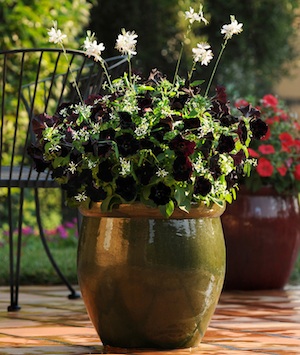Containers open up new options for plantings
by M. Roll and C.R. Wilson
Container considerations

Just about any container can be used, including clay (often called terra cotta), plastic pots, wood barrels, wire baskets lined with sphagnum moss or coconut coir, planter boxes, ceramic pots (often found in bold colors), and even cement blocks. However, make sure you never use a container that held toxic materials, especially if edible plants are going to be grown.
No matter the container, the most important thing to consider is drainage. Plants will not grow successfully in soil that is continually waterlogged. In waterlogged soils, space fills with water leaving no room for air, which is necessary for proper root growth. If there are no existing drainage holes in the container, make multiple holes in the bottom. Keep in mind that containers made from porous materials (like clay and wood) lose moisture quickly, but allow air movement into the root zone. However, metal, plastic, and glazed containers hold water longer, but restrict air movement making drainage holes especially important. Use a container insert if you plan to use an expensive decorative container without drainage holes. Make sure the insert does not rest in water.
Consider whether your pots will be moved during the growing season. When water is added to soil in an already heavy container, the weight may be too much to lift easily. Plan ahead when planting large containers and add container dollies with wheels. Keep in mind tall plants require a heavier container to avoid tipping over from imbalance or offering too much wind resistance.
The container should be large enough so the plants won’t dry out between waterings. Many vegetables, herbs, and flowers will not be productive if they are allowed to wilt. Containers of minimum size hold less moisture, especially when the roots are crowded. They will need more daily maintenance during the heat of summer. Consider using a slightly larger container with more soil to hold moisture and reduce maintenance.
The size of the container should accommodate the roots of the plants when fully grown. Plant vegetables such as tomatoes, eggplant, pepper, cucumbers, cabbage, and beans in a minimum of five-gallon containers. Beets, carrots, lettuce, and green onions can be planted in three-gallon containers. Most herbs and radishes grow well in containers of one gallon or less. With flowers, a general rule is the larger the height of the flower, the more root mass is produced thus requiring a larger container.
Soil choice
Potting soil should be free of disease organisms, insects, and weed seeds. It should be porous yet hold water and nutrients with a slightly acidic pH. Do not use native soil, even if you can pasteurize it. Most native soils have a high percentage of clay particles that easily compact reducing the oxygen that is available to the roots. Potting soil may contain pasteurized soil, sphagnum peat moss, vermiculite, perlite, and composted manure.
Never reuse the same potting soil from the previous growing season because it may contain disease organisms.
Soilless mixes contain many of the same ingredients as potting soil, but are two to three times lighter because they don’t contain heavy soil. Common ingredients include peat moss and/or ground bark to hold water and nutrients; vermiculite for water retention; and perlite to loosen the mix and allow for air movement. You can add up to 10 percent of the volume with clean, coarse sand to add weight for top-heavy plants.
The rapid growth of many container plants quickly depletes the fertilizer available in the limited volume of soil. Well-drained soil mixes also result in the regular loss of fertilizer in the drainage water.
To provide the right amount of fertilizer, mix controlled-release fertilizer granules into the soil mix at planting. The large number of plants often grown in containers places extra demands on the fertilizer supplied by timed-release products. Fully soluble fertilizer products can be added to the irrigation water to supplement or replace timed-release products.
For the full article, see the May 2011 issue of Landscape Management magazine.
M. Roll and C.R. Wilson are Colorado State University Extension horticulture agents.

